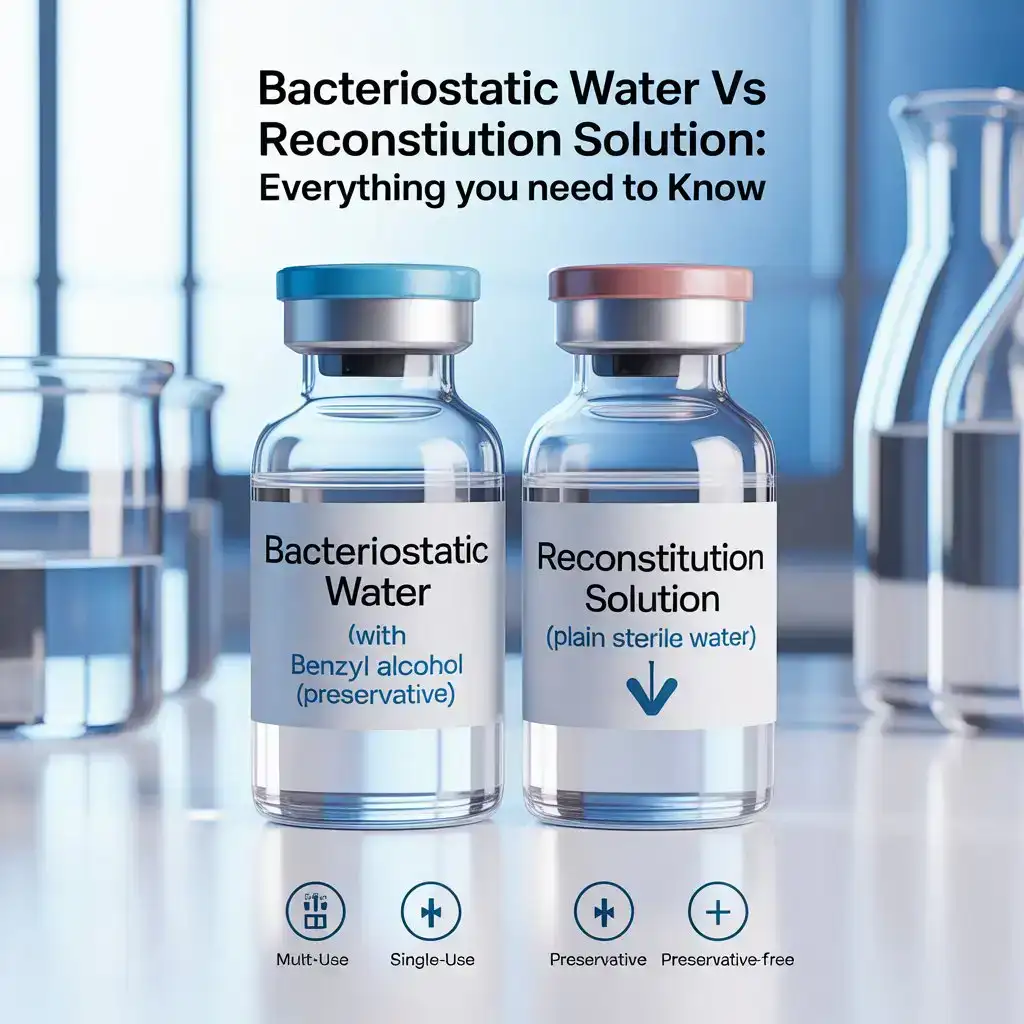When preparing medications, peptides, or research compounds, choosing the right diluent is crucial for accuracy, stability, and safety. Two commonly used options are bacteriostatic water and reconstitution solution. While both serve similar purposes, they differ in composition, applications, and suitability for certain procedures. In this article, we’ll explore the differences between bacteriostatic water vs reconstitution solution, their uses, benefits, and how to choose the right one for your needs in USA.
Table of Contents
What Is Bacteriostatic Water?
Bacteriostatic water is sterile water for injection that contains 0.9% benzyl alcohol as a preservative.
Key Features of Bacteriostatic Water:
- Contains an antimicrobial agent (benzyl alcohol) that prevents bacterial growth.
- Packaged in multi-use vials, allowing repeated withdrawals.
- Typically used for diluting medications, peptides, and hormones.
- Must be discarded within 28 days after opening to maintain sterility.
What Is a Reconstitution Solution?
A reconstitution solution (often sterile water or saline) is a solvent used to dissolve or dilute powdered medications into injectable form.
Key Features of Reconstitution Solution:
- Usually plain sterile water, saline, or specific diluents recommended by manufacturers.
- Does not contain preservatives.
- Comes in single-use vials to avoid contamination.
- Commonly used for vaccines, antibiotics, and sensitive drugs.
Bacteriostatic Water vs Reconstitution Solution: Key Differences
| Feature | Bacteriostatic Water | Reconstitution Solution |
| Composition | Sterile water + 0.9% benzyl alcohol | Sterile water or saline (no preservatives) |
| Shelf Life | Multi-use (up to 28 days after opening) | Single-use only |
| Applications | Hormones, peptides, injections requiring multiple doses | Antibiotics, vaccines, drugs requiring one-time reconstitution |
| Safety | Not suitable for newborns due to benzyl alcohol | Safer for sensitive drugs and infants |
| Cost Efficiency | More economical for multiple uses | Designed for one-time precise use |
When to Use Bacteriostatic Water
Bacteriostatic water is best suited for:
- Reconstituting peptides and hormones.
- Multiple-dose vials where repeated withdrawals are needed.
- Research labs requiring longer usability of a vial.
Important: Not recommended for infants or for drugs where preservatives may alter stability.
When to Use Reconstitution Solution
Reconstitution solutions are ideal for:
- Single-dose medications.
- Sensitive compounds that must remain preservative-free.
- Vaccines, antibiotics, and biologics requiring accurate, one-time mixing.
Pros and Cons
Advantages of Bacteriostatic Water:
- Longer usability after opening.
- Cost-effective for frequent use.
- Antimicrobial protection against contamination.
Disadvantages of Bacteriostatic Water:
- Not safe for infants.
- Preservatives may not be compatible with all drugs.
Advantages of Reconstitution Solution:
- High safety for sensitive drugs.
- No preservatives (pure solvent).
- Recommended by manufacturers for specific medications.
Disadvantages of Reconstitution Solution:
- Must be used immediately after opening.
- Less cost-efficient for repeated use.
Choosing the Right Option: Bacteriostatic Water or Reconstitution Solution?

The choice between bacteriostatic water vs reconstitution solution depends on:
- Type of medication (multi-dose vs single-dose).
- Patient safety requirements (infants and sensitive drugs need preservative-free).
- Cost considerations (multi-use vials vs single-use).
- Manufacturer’s guidelines (always check instructions before reconstitution).
FAQs
1. Can bacteriostatic water be used for all injections?
No. Some medications require preservative-free diluents for safety and stability.
2. Why is benzyl alcohol added to bacteriostatic water?
It acts as a preservative, preventing bacterial growth in multi-use vials.
3. Can I substitute bacteriostatic water for reconstitution solution?
Not always. It depends on the medication’s stability and safety requirements.
4. Which option is safer for infants?
Reconstitution solution is safer because it does not contain benzyl alcohol.
Conclusion
Both bacteriostatic water and reconstitution solution are essential in medical and research settings, but they serve different purposes. Bacteriostatic water is best for multi-dose applications, while reconstitution solution ensures safety for sensitive drugs and single-use injections. Always follow manufacturer recommendations and consult healthcare guidelines before choosing a diluent.
for read more blogs click here


